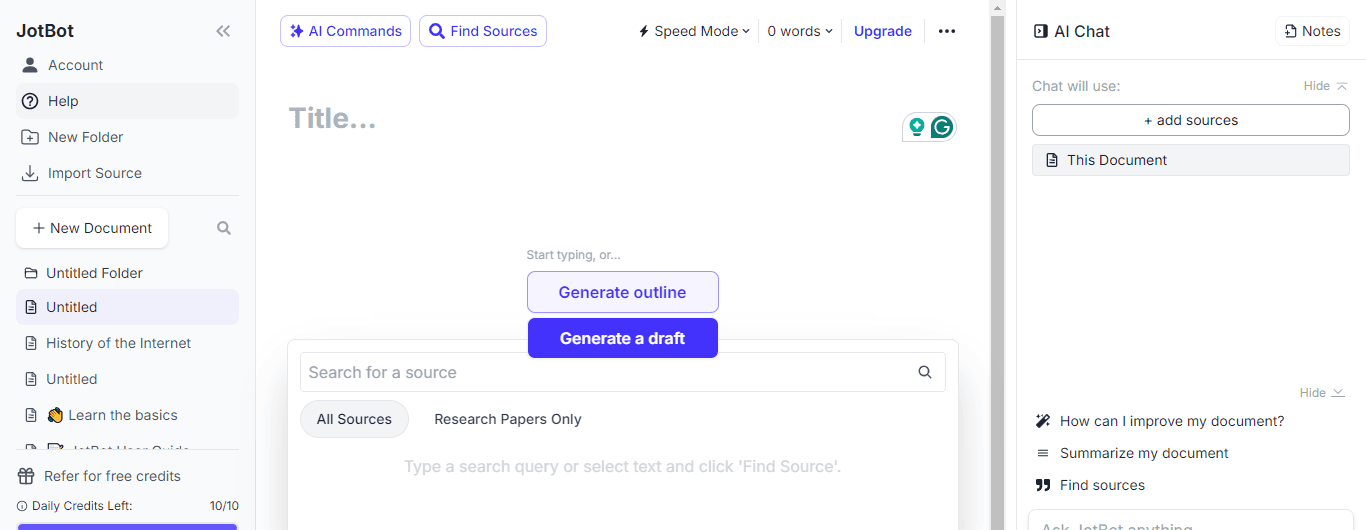< Back
A Step-by-Step Guide on How to Find Scholarly Sources
Declan Gessel
Oct 4, 2024
Researching for a paper can be stressful. First, you need to choose a topic. Then, you have to find sources for essay AI. What if you get stuck on this step? What if you can’t find the suitable sources? What if all the sources you find are outdated or unreliable? This is a common problem for students and can be incredibly frustrating. Artificial intelligence tools can help you find sources for your research paper quickly and effectively.
This guide will teach you how to find scholarly sources. Then, we’ll introduce you to JotBot’s source finder, an AI tool that can help you find precise, reliable sources for your following paper.
Table Of Contents
Best Practices for Finding the Best Academic Research Sources
Write Smarter With JotBot's Source Finder — Start Writing for Free Today
What Are Scholarly Sources?

Scholarly sources are publications that have undergone a rigorous peer review and are typically written by experts in a specific field. They are characterized by their reliance on empirical evidence, detailed analysis, and citations of other credible works. The purpose of scholarly sources is to contribute to academic discourse and advance knowledge in a particular area of study.
Key characteristics of scholarly sources include:
Authorship
Scholarly sources are authored by researchers, academics, or professionals who are experts in the subject matter. This background often lends credibility to the work.
Peer Review
Scholarly works are usually subjected to peer review before publication, where other experts in the field evaluate the research for quality, accuracy, and relevance. This process helps ensure that only credible and significant contributions are published.
Citation of Sources

Scholarly sources include citations and references to other works, demonstrating the research’s foundation and allowing readers to trace the origins of the ideas presented.
Formal Structure and Language
These publications typically follow a structured format, including an abstract, methodology, results, and discussion sections. The language used is formal and technical, suitable for an academic audience.
Why Are Scholarly Sources So Important?
Using scholarly sources is critical for several reasons:
Credibility
Academic communities view scholarly sources as reliable and authoritative. When researchers reference these sources, they bolster the credibility of their work. This is particularly important when writing essays, dissertations, or articles for academic publication.
Depth of Research
Scholarly sources often provide comprehensive insights into a topic, covering various angles and perspectives. This depth enables researchers to gain a well-rounded understanding of their subject matter and supports the development of well-informed arguments.
Support for Claims
Academic writing often requires evidence to back up claims. Scholarly sources provide this evidence through data, case studies, and theoretical frameworks, helping writers substantiate their points and add rigor to their analyses.
Contribution to Academic Discourse
Using scholarly sources, writers participate in the ongoing conversation within their field of study. Citing these works demonstrates engagement with existing research and contributes to knowledge development.
Avoiding Plagiarism
When writers use scholarly sources and properly cite them, they acknowledge the original authors’ contributions and avoid plagiarism. This practice upholds academic integrity and reflects respect for others' intellectual property.
Related Reading
• How To Find Good Sources
• Using AI For Research
• Citing ChatGPT
• How To Find Academic Sources
• How To Cite AI In MLA
• AI For Research Paper Writing
• Essay Sources
• AI In Academic Writing
• Most Reliable Sources For Research
• How To Get ChatGPT To Cite Sources
Types of Scholarly Sources

Finding Primary Sources: The Gold Standard of Research
Primary sources are original materials that provide direct evidence or firsthand accounts of a topic. They are not interpretations or evaluations of other sources. Common examples include:
Original Research Articles
These contain the results of research studies, including details about the methodology, data collected, and findings.
Theses and Dissertations
Written by graduate students as part of their academic programs, these works provide in-depth analysis and original research on specific topics.
Conference Papers
Presentations or papers that share new research findings or ideas are delivered at academic conferences.
What to Do: Search Academic Databases
Use databases like Google Scholar, JSTOR, or your university's library portal to find original research articles. Look for keywords like “study,” “research,” or “analysis” in the title or abstract.
Review the Methodology Section
When evaluating research articles, consider the methodology section to understand how the study was conducted. This will help you assess the validity of the findings.
What to Look Out For
Ensure the article is peer-reviewed, which adds credibility to the research.
Be mindful of the publication date; newer studies may provide updated insights.
Finding Secondary Sources: The Interpretive Layer of Research
Secondary sources interpret, analyze, or summarize information from primary sources. They provide context and a broader understanding of the research topic. Examples include:
Review Articles
These articles summarize and analyze findings from multiple primary research studies on a specific topic.
Books and Textbooks
Academic books that discuss various theories, methods, or histories related to a field.
Documentary Films
Films that provide commentary or analysis of events or studies, often incorporating primary source materials.
What to Do: Utilize Literature Reviews
Search for review articles in academic databases. These can provide a comprehensive overview of existing research on your topic.
Check University Libraries
Many university libraries have collections of academic books that provide valuable insights into various subjects.
What to Look Out For
Verify the author's qualifications and expertise in the field.
Ensure the sources cited within the secondary sources are credible and relevant.
Finding Tertiary Sources: The Starting Point of Research
Tertiary sources compile and summarize information from primary and secondary sources. They serve as a starting point for research, offering a broad overview of topics. Examples include:
Encyclopedias
Comprehensive reference works that summarize information on a wide range of subjects.
Bibliographies
Lists on a particular topic can lead you to primary and secondary sources.
Fact Sheets
Quick reference documents that provide essential information or statistics on a specific topic.
What to Do: Use Online Encyclopedias
Websites like Britannica or specialized academic encyclopedias can provide a solid foundation for understanding your research topic.
Compile Bibliographies
Look for bibliographies in review articles or textbooks to find reputable primary and secondary sources.
What to Look Out For
Ensure the tertiary source is reputable and recognized in the academic community.
Use tertiary sources as starting points, but seek out primary and secondary sources for more in-depth research.
Write more brilliantly, not harder, with JotBot's AI writing assistant. Start finding sources for free with JotBot's source finder today. Sign in with Google and get started in seconds.
Related Reading
• Best AI Tool For Research
• Reference Finder
• Best AI For Research
• How to Cite AI
• AI For Literature Review
• Websites Like Google Scholar
• AI That Cites Sources
• Best Academic Search Engines
• Academic Research Software
• How To Use Chat GPT For Research
• Best Research Tools For Students
A Step-by-Step Guide on How to Find Scholarly Sources

Step 1: Identify Your Research Topic
The first step in finding scholarly sources is clearly defining your research topic. A well-defined topic helps narrow your search and increases the likelihood of finding relevant sources.
What to Do
Brainstorm Ideas: Write down your initial thoughts or questions about the topic. Consider what interests you or what gaps in knowledge you want to explore.
Refine Your Topic: Narrow your ideas into a research question or thesis statement. Make sure it is focused enough to guide your search.
What to Look Out For
Ensure your topic is narrow enough (which can lead to overwhelming information) and narrow enough (which can limit available sources).
Consider the scope of your research—what aspects of the topic you want to cover.
Step 2: Use Academic Databases
Academic databases are essential tools for locating scholarly sources. They offer access to various journals, articles, and other educational materials.
What to Do
Choose Your Database: Select databases relevant to your field of study, such as:
Google Scholar: A freely accessible search engine for scholarly articles.
JSTOR: A digital library for academic journals, books, and primary sources.
PubMed: A database for life sciences and biomedical literature.
ERIC: A database for education-related research.
Conduct Your Search
Use Keywords: Enter specific keywords related to your research topic. To refine your search, use quotation marks for phrases and Boolean operators (AND, OR, NOT).
Apply Filters: Utilize filters to limit results by publication date, type of publication (e.g., peer-reviewed), or subject area.
What to Look Out For
Scan the abstracts to assess the relevance of the articles.
Note any specific methodologies or results that are particularly useful for your research.
Step 3: Explore University Library Resources
University libraries are treasure troves of academic resources, including books, journals, and archives. They often provide access to materials that are not freely available online.
What to Do
Access the Library Catalog: Use your university’s online library catalog to search for books and journals related to your topic.
Utilize Interlibrary Loan Services: If your library does not have a specific resource, you can request it through interlibrary loan services, allowing you to borrow materials from other libraries.
What to Look Out For
Check if the library offers access to digital resources such as e-books or online journals.
Utilize the help desk or library staff for assistance in navigating resources or finding specific materials.
Step 4: Utilize Reference Lists and Citations
Exploring the reference lists and citations of relevant articles can lead you to additional valuable sources.
What to Do
Review Reference Lists: When you find a particularly relevant scholarly article, check its reference list for other valuable sources.
Use Citation Tracking: Some databases, like Web of Science or Scopus, allow you to see who has cited a specific article. This can lead you to newer research that builds upon the original work.
What to Look Out For
Look for seminal works in the reference lists that provide foundational information for your research topic.
Pay attention to how often specific sources are cited, which may indicate their influence and relevance in the field.
Step 5: Leverage Online Academic Networks
Online academic networks are platforms where researchers share their work and collaborate with others in their fields. These networks can provide access to unpublished research and foster connections with experts.
What to Do
Join Platforms: Create accounts on academic networking sites like ResearchGate, Academia.edu, or Mendeley.
Follow Researchers: Engage with researchers in your field and follow their work to stay updated on the latest findings.
What to Look Out For
Look for frequently cited researchers in your study area; they may have valuable insights or unpublished data that could benefit your research.
Engage in discussions or ask questions about their work to deepen your understanding of the topic.
Write smarter, not harder, with JotBot's AI writing assistant. Start finding sources that are accessible with JotBot's source finder today. Sign in with Google and get started in seconds.
Best Practices for Finding the Best Academic Research Sources

Mix it Up: Why You Need a Variety of Sources
Utilizing various sources is essential to ensure a well-rounded perspective on your research topic. Relying on a single source type can lead to biased information and a narrow understanding of the subject.
What To Do
Mix Source Types: Incorporate primary, secondary, and tertiary sources into your research. For example, combine original research articles (primary) with review articles (secondary) and encyclopedic entries (tertiary) to gain a comprehensive view.
Use Different Formats: To enrich your research, Include books, journal articles, conference papers, reports, and credible websites. Each format can provide unique insights and data.
What To Look Out For
Ensure that each source type you include contributes to a better understanding of the topic.
Avoid over-relying on one source type, such as only reviewing articles that may not provide original data.
Verify Credibility: How to Assess Scholarly Sources Quickly
Assessing the credibility of sources is crucial for ensuring that the information you are using is accurate and trustworthy. High-quality sources contribute to the reliability of your research.
What To Do
Check Author Credentials: Look for information about the author’s qualifications, affiliations, and other works. Authors with relevant academic backgrounds and publications are more likely to produce credible research.
Evaluate Publication Reputation: Consider where the source was published. Peer-reviewed journals and reputable publishers are indicators of credibility. Use metrics such as journal impact factors to gauge the journal's influence.
What To Look Out For
Be cautious of sources that lack author information or are published in non-peer-reviewed platforms.
Avoid using sources with sensationalist headlines or questionable claims without supporting evidence.
Stay Current: Why Recent Research is Key to Your Essay
Staying updated with the latest research is critical in many fields, especially in fast-evolving areas like technology or health sciences. Using outdated sources can lead to inaccuracies and misrepresentations.
What To Do
Prioritize Recent Publications: Aim to include sources published within the last 5 years unless you are discussing foundational theories or historical perspectives.
Set Alerts for New Research: Use database features to set up alerts for specific keywords or topics so you will receive notifications when new research is published.
What To Look Out For
Regularly check the publication dates of your articles to ensure they are relevant to your research.
Be aware of significant updates in your field that may change previous understandings or practices.
Organize Your Findings: How to Manage Research Sources Efficiently
Organizing research sources efficiently is vital to developing coherent and well-structured academic work. A systematic approach to managing sources can save time and reduce frustration during the writing process.
What To Do
Use Citation Management Tools: Utilize tools like Zotero, Mendeley, or EndNote to organize your sources. These tools can help you quickly collect, manage, and format citations and bibliographies.
Create an Annotated Bibliography: As you gather sources, create an annotated bibliography summarizing each source's key points and relevance to your research. This will help you recall information quickly when writing.
What To Look Out For:
Ensure all sources are correctly formatted and consistently cited according to your chosen citation style (e.g., APA, MLA).
Regularly update your bibliography as you find new sources to keep your research organized.
How JotBot Can Help You Find Scholarly Sources Effectively

JotBot’s Unique Features for Scholarly Research
JotBot is designed to enhance the research experience by offering a range of features tailored to the needs of students, researchers, and writers. Its capabilities help users efficiently locate, organize, and cite scholarly sources.
AI Source Finder
Utilize JotBot’s AI-powered source finder to locate relevant scholarly articles and research materials. Input your research topic or keywords, and JotBot will generate a list of credible sources based on your query.
Automatic Citation Generation
Take advantage of JotBot’s ability to automatically generate citations in various formats (APA, MLA, Chicago). This feature saves time and ensures accuracy in your references.
What to Look Out For: Ensure you input specific and relevant keywords to get the most accurate source suggestions from JotBot. Review the generated citations for correctness, as automated tools occasionally have errors.
Step-by-Step Guide to Using JotBot’s Source Finder

To maximize the benefits of JotBot, users can follow a straightforward guide to utilize its source-finding capabilities effectively.
Sign Up for JotBot
Create an account by signing in with Google. This process takes only seconds and grants you access to JotBot’s features.
Input Your Research Topic
Navigate to the source finder feature. In the search bar, enter your research question or topic keywords. Be as specific as possible to yield better results.
Review the Suggested Sources
After entering your query, review JotBot's list of suggested sources. Click on each source to access abstracts or full articles, where available.
Utilize AI Note-Taking
While reviewing articles, use JotBot’s AI note-taking feature to summarize key points, quotes, and insights directly from the source. This allows for efficient information capture and organization, making it easier to reference later.
Generate Citations
Once you’ve gathered your sources, use JotBot to generate each citation. Select your preferred citation style, and JotBot will format the citations correctly. Review each citation for accuracy and make any necessary adjustments before adding them to your bibliography.
What to Look Out For: Familiarize yourself with JotBot’s user interface to enhance efficiency. Customize your search using advanced search options, such as filtering by publication date or source type.
Write more brilliantly, not harder, with JotBot's AI writing assistant. Start finding sources free with JotBot's source finder today — sign in with Google and get started in seconds.
Write Smarter With JotBot's Source Finder — Start Writing for Free Today

JotBot is your personal document assistant and source finder. JotBot does AI note-taking, AI video summarizing, and AI citation/source finder; it writes AI outlines for essays and even writes entire essays with JotBot’s AI essay writer. Join 500,000+ writers, students, teams, and researchers worldwide to write more, write better, and write faster with JotBot's AI writing assistant.
Write more brilliantly, not harder, with JotBot's AI writing assistant. Start finding sources that are accessible with JotBot's source finder today. Sign in with Google and get started in seconds.
Related Reading
• Academic Sources Examples
• Scholarly Sources Examples
• Sourcely
• AI Research Tools
• Elicit AI
• Scisummary
• Scholarcy AI
• Consensus AI Tool
• Mendeley Alternatives
• Cite This For Me Alternative
• List of Scholarly Sources
• Examples of Peer Reviewed Sources
• How to Cite a Book
• How to Cite an Article
• How to Cite
• How to Cite a PDF
• How to Cite Multiple Authors MLA
•How to Cite a Website in Text
• How to Cite a Lecture
• How to Cite ChatGPT
Write more, better, faster.
Your personal AI document assistant












